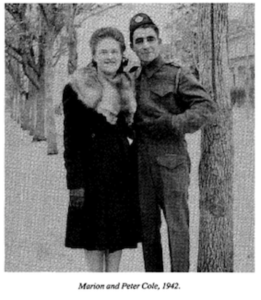Blessed Virgin Mary the Protectress Church and East Selkirk Cemetery
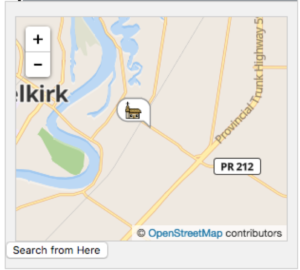
Site Location (lat/long): N 50° 08.248 W 096° 50.109
Location: West off Highway 59, at junction of Colville Road (PTH 212) and Old Henderson Highway
Contact People:
- St. Mary’s Ukrainian Catholic- Mrs. Stella Dubas 204-482-5860
- St. Stanislaus Roman Catholic Church- Mrs. Judith Jaworski 204-785-1397
- St. Michael’s Ukrainian Orthodox- Mr. Dennis Chyborak 204-482-4691
Facilities: None at cemetery
East Selkirk Cemetery Student Activities:
Download Student Activities PDF or Download Student Activities Word Document
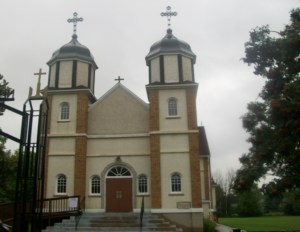
Why Blessed Virgin Mary the Protectress is Historically Significant
Although the Ukrainian settlement in East Selkirk began in 1898, it did not have a church building until a small wooden structure was built in 1909 known as St. Mary’s Church. This first structure was destroyed by a fire on Easter Sunday in 1914. The same year a new larger wooden church was built.
By the early 1950’s, the congregation had grown in numbers and the present-day site was obtained for the construction of a larger church, with a full basement, at the corner or Old Henderson and Colville Road. The newer brick and stucco church has a belfry or bell tower, housing two bells to announce Sunday and church holiday services.
The church is adorned with two cupolas or dome-shaped steeples on either side of the main entrance into the church. The architectural designer was Reverend Father P. Ruh who was responsible for the creation of many churches across Western Canada with similar layouts.
The churches of Ukraine (Orthodox and Catholic) have evolved from the Greek Byzantine rite churches. The Ukrainian Catholic church, also historically called the Ukrainian (Ruthenian) Uniate or Greek Catholic church, affirms the doctrine taught by the Catholic church with Rome for the most part its governing see. Through the Union of Berestia in 1596, the Ukrainian church entered into a union with the Roman Catholic church. At that time, Pope Clement VIII had guaranteed the Ukrainian church to keep its Byzantine rite including all its Liturgical practices and architecture.
The interior has a cross shaped floor plan or cruciform. The church entrance is preceded by a large number of steps to symbolize the ascent into heaven. Behind the two front doors is a small vestibule, that is closed off from the main area or nave that seats the congregation, by two French doors adorned with coloured glass panes. The choir loft is housed above the vestibule and is accessed by a winding staircase near the back wall to the left of the French doors.
Beyond the nave is the semicircular recess with a domed roof where the sanctuary is located. This area is known as the apse and the central focus is the main altar. The church lacks a tradition iconostasis or screen of icons that separate the nave from the sanctuary. Instead the parish has placed two icons on two raised decorative stands that are between the altar and the small table called the tetrapod. The tetrapod holds candles, a crucifix and two portable icons.
Easter is one of the most beautiful celebrations in the Byzantine churches. The solemn Holy Week recognizes the crucifixion of Jesus Christ and is followed on Easter Sunday by the declaration of the Resurrection of the Risen Christ into Heaven. Traditionally baskets of foods that symbolize Easter are taken to church prior to the Easter Sunday Liturgy to be blessed by the priest. On returning from church on Easter morning the foods are then shared by the families as they proclaim, “Christ has Risen!” and respond with “Indeed He has Risen!”
The centre section of the “East Selkirk Cemetery” is the final resting place of members of the congregation.
East Selkirk Cemetery
This cemetery is (or these 3 cemeteries are) on Ferry Rd (Hwy 212), 0.4 miles northeast of Hwy 204 in East Selkirk, Manitoba. The sign on the gate says, “East Selkirk Cemetery.”
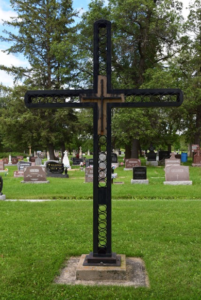
The East Selkirk Cemetery is located on the south west side of Ferry Road in East Selkirk, Manitoba. The land is four and one hundredths acres and was part of the Dominion Lands Titles granted by King George V of Great Britain for the sole purpose of cemetery burial plots in the year 1925.
The East Selkirk Cemetery is a place of rest for deceased members of three local parishes of the East Selkirk community. The land was given to the Ukrainian Ruthenian Greek Catholic church, known as the Blessed Virgin Mary the Protectress Church of East Selkirk. The East Selkirk Cemetery is divided by two parallel roads leading into the cemetery ground that separate three areas denoted for burial plots for the churches of the Ukrainian Greek Orthodox Church, the Blessed Virgin Mary the Protectress Church, and St. Stanislaus Roman Catholic Church.
| St. Michael's Ukrainian Orthodox | St. Mary's Ukrainian Catholic | St. Stanislaus Roman Catholic |
|---|---|---|
| South Side- 1916 | Middle Section- 1913 | North Side- 1913 |
Dominion Land Grant
Dominion Lands Grant Title
Deputy Governor
Canada
George the Fifth, by the Grace of God,
of the United Kingdom of Great Britain and
Ireland and of the British Dominions beyond
the Seas King Defender of the Faith,
Emperor of India.
To all whom these Presents shall come ~
Greeting:
Whereas the lands hereinafter mentioned are Dominion Lands within the meaning of the Dominion Lands Act.
And Whereas under and by virtue of the provisions of the said Act in that behalf, the said lands have been duly set apart and appropriated for the public purpose hereinafter mentioned and authority hath been given for a free grant thereof for such purposes to the Ruthenian Greek Catholic Parish of the Protection of the Blessed Virgin Mary, at East Selkirk, in the Province of Manitoba, in Our Dominion of Canada, a body corporate and politic, hereafter called the Corporation.
Now Know Ye that We do hereby grant, convey and assure unto the Corporation, its successors and assigns all and singular that Parcel or Tract of Land, situate, lying and being in East Selkirk Town site, in the Province of Manitoba, in Our Dominion of Canada, and being composed of all that portion of Lot numbered Seventy-one in East Selkirk Town site aforesaid which may be more particularly described as follows: – Commencing at the South East corner of the said Lot, thence North-Easterly along the South East boundary of the said Lot to a point equidistant between the North-East and South-West boundaries of the said Lot: thence North-Westerly along the line which lies equidistant between the said North-East and South-West boundaries, to its intersection with the right bank of West Slough; thence South-Westerly along the said right bank to the South-West Boundary of the said Lot; thence South-Easterly along the said South-West boundary to the place of commencement, as shown upon a map or plan of Survey of the said Town site, approved and confirmed at Ottawa, on the 18th day of June, A.D., 1902, by Edouard Deville, Surveyor General of Dominion Lands, and of record in the Department of the Interior, containing of admeasurement Four and one hundredths acres more or less.
Saving and reserving, nonetheless, unto Us, Our Successors and Assigns, the free uses, passage and enjoyment of, in, over and upon all navigable waters that now are or may be hereafter found on or under, or flowing through or upon any part of the said Parcel or Tract of Land; also reserving all mines and minerals, whether solid, liquid or gaseous, which may be found to exist within upon, or under such lands, together with full power to work the same, and for this purpose to enter upon, use and occupy the said lands or so much thereof and to such extent as may be necessary for the effectual working and extracting of the said minerals; and also reserving thereout and therefrom all rights of the fishery and fishing and occupation in connection therewith upon, around and adjacent to the said lands, and also the privilege of landing from and moving boats and vessels upon any part of the said lands and using the said lands in connection with the rights of fishery and fishing hereby reserved, so far as may be reasonably necessary to the exercise of such rights.
To have and to hold the same unto the use of the Corporation, its successors and assigns, so long as the same are, and upon the trust and subject to the condition that the same shall be used for cemetery purposes and for no other purpose or purposes whatsoever.
Provided always, and these presents are issued upon the subject to the following condition, namely: That if the Corporation, its successors or assigns, shall at any time hereafter fail or neglect to use the said lands for the purpose of foresaid, or if the Corporation, its successors or assigns, shall use the said lands for any other purpose, then and in any of the said cases it shall be lawful for Our Minister of the Interior of Canada, by writing under his hand to cancel these presents and upon such cancellation these presents and the grant thereby made shall become null and void, and the said lands shall thereupon become and be vested in Us as of Our former estate and interest therein.
Given under the Great Seal of Canada. Witness, Fredrick Fiat No. 463699
Linwood Clinton Pereira, Esquire Deputy of Our Special Grant No. 8201
Right Trusty and Well-beloved Julian Hedworth
George Baron Byng of Vimy, General on the
Retired List and in the Reserve of Officers of our
Army, Knight Grand Cross of Our Most
Honourable Order of the Bath, Knight of Grand
Cross of Our Most Distinguished Order of Saint
Michael and Saint George, Member of Our Royal
Victorian Order, Governor General and
Commander-in-Chief of Our Dominion of Canada.
At Ottawa, this Thirteenth day of May in the year of Our Lord, one thousand nine hundred and twenty-five and in the sixteenth year of Our Reign.
By Command,
Under– Secretary of State. for Deputy of the Minister of the Interior.
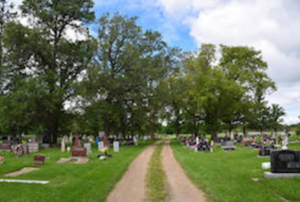
East Selkirk Cemetery Stories
Cemetery Story 1- Immigration to St. Clements
A journey through a cemetery reveals many interesting facts about a community. The East Selkirk Cemetery provides a glimpse of some of the early immigrants who settled in St. Clements, and their cultures.
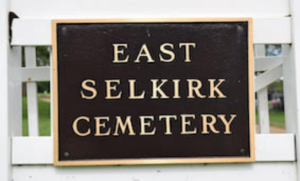
Between the 1880’s and 1920’s, in St. Clements, the largest group of immigrants came from central and eastern Europe. There, Austria–Hungary ruled over two provinces in Ukraine called Galicia and Bukovina and they allowed Poland to be in charge of the Ukrainian people. They did not allow the Ukrainian people to attend their Orthodox Church. Russia was in charge of the eastern provinces and treated them very badly. They were not even allowed to speak their own language. The poorer people in both of these areas did not have enough land to live on or farm. Also, Hutterites from Germany and Mennonites and Doukhobors from Russia were having similar problems.
They were all looking for a better place to live and Canada, the United States and Brazil welcomed them as immigrants. Hundreds of thousands of Ukrainian, Polish, German and Russian people left their homes and families to find a better life.
Between 1890 and 1914 the immigrants travelled by ship and train to get to their new homes. Many people died on the journey due to overcrowding and illness on the ships. When they did land in Canada they boarded trains to the west. Many stopped in Winnipeg but others came to the Immigration Shed in East Selkirk. Upon arrival, they were given about 160 acres of land free. In their homeland, they would have had about 7 acres.
They settled in East Selkirk, Libau, the Beaches and in Narol-Gonor. Using timber for building and fuel they mainly built two styles of houses, Galician and Bukovinian. They found work on logging crews, railway lines and in mines. Most became vegetable farmers.
Manitoba’s Ukrainian Settlers
Over one hundred fifty years have passed since the first wave of European immigrants made their way to a new country (Canada). Leaving their homeland, they were in search of a better way of life on land they could call their own.
In 1891 when the first large group of Ukrainians arrived on the edge of the Canadian Prairies, the land was still sparsely occupied. Two railways, CPR and CNR, crossed the vast expanse that was once called the Northwest Territory stretching to the newly acquired Province of British Columbia. Under Prime Minister Sir Wilfred Laurier, the newly appointed Minister of Internal Affairs, Clifford Sifton, spearheaded immigration plans to procure people who might be successful in farming the large fertile prairies of Canada’s west. Deals were established with the North Atlantic Shipping
Company from Hamburg, Germany to transport families from Europe to Halifax or Montreal. From these cities immigrants would board trains to head westward.
It was during this time that Ukrainian was experiencing economic turmoil and political uprising. Those who were able, seized the opportunity to relocate to Canada where they could obtain almost free parcels of land under the Dominion Land Grant Act. As well they would have freedom to practice their own religion without political interference.
Unfortunately, after 1895, Immigration Officers could choose the location of new immigrants’ homesteads. The most productive lands and those closest to railway lines were given to those who did not need financial assistance by the government. Many of the poorest families were left alone on remote parcels of land. The father, as head of the household would need to work elsewhere on the rail lines or building roads far from home to help bring in the income needed for equipment and survival on a homestead. Some families perished under harsh and difficult conditions. Differences in language, culture and social status played a part in the struggle to gain confidence and to prosper in a relatively young country with a changing evolving society. Canada became uniquely multicultural without become a “melting pot”. Immigrants from many nations proudly celebrated and acknowledged their cultural roots in small communities.
There were many Ukrainian communities located throughout Manitoba – south, west, east and north of Winnipeg. Between 1899 and the early 1900’s, tens of thousands of immigrants made homesteads in areas along lakes, the Interlake and to the Saskatchewan and Ontario borders. Later some would seek employment in the mining industry and establish roots as far north as Flin Flon, The Pas and Thompson. The home, garden, and church community was still an integral part of the life and cultural identity.
Post World War I and II, when economic conditions were more stable in Canada, another large immigration of 50 thousand Ukrainians arrived between 1926 and 1929. An additional 16 thousand came in 1939 to escape Stalin’s rule of Ukraine under a Soviet Regime.
The 1951 census stated Canada’s population as 14 004 429. Those of Ukrainian origin were reported as 395 043. In Manitoba, 98 753 out of a provincial population of 776 541 were said to be of Ukrainian descent. Of these numbers, half lived in rural and half in urban communities. In Winnipeg, with a population of 354 068 at that time, one eighth to one ninth were stated to be of Ukrainian origin.
Many towns, schools, and churches were established by Ukrainians who were faithful and determined to make Canada a home for their children for generations to come. With much perseverance and sometimes years of exhaustive toil, immigrants of European backgrounds made much of Manitoba’s wilderness into productive farmlands and beautiful towns and cities. Ukrainians have shared in this transformation through the use of their strong faith, artistic and cultural influence. Thus hoping for betterment of their community and country. The contributions of Ukrainians to their new adoptive homeland only strengthened the multicultural mosaic of the many nations who now also call Canada their “Home and native land”.
The following are examples of where Ukrainian settlers homesteaded in Manitoba and dates of establishment of Ukrainian Churches. Most contained Ukrainian churches and cemeteries that reveal their birthplace in Ukraine. Many of these towns have now been abandoned.
Winnipeg and Area: Between 1901 – 1926, sixteen Ukrainian urban Parish communities were established.
North of Winnipeg
| 1897 | Pleasant Hope |
| 1899 | Gonor |
| 1903 | Ladywood- Beausejour |
| 1904 | Brokenhead |
| 1908 | East Selkirk |
| 1910-1911 | Garland |
| 1913 | Poplarfield |
| 1900-1914 | Foley North and Interlake- Gimli, Fraserwood, Arnes, Zbruch, and Komarno |
| 1914-1915 | Fletcher |
| 1915-1917 | Rembrandt |
| 1918 | Silver |
| 1918 | Meleb |
| 1918 | Sylvan |
Dauphin Area
| 1897 | Dauphin |
| 1898 | Trembowla |
| 1900 | Ethelbert |
| 1902 | Keld |
| 1903 | Mink Creek |
| 1903 | Zoria |
| 1906 | Ashville |
| 1918 | Pulp River, Cowan, Scalter |
South and West of Winnipeg
| 1898 Stuartburn | 1899 Shoal Lake (Shoyllyk) |
| 1902 Tolstoi | 1904 Mountain Road near Neepawa |
| 1904 Olha and Lakedale | 1904 Ozerna and Sandy Lake |
| 1903-1905 Brandon | 1906 Portage la Prairie |
| 1906 St. Norbert | 1907 Caliento |
| 1907 Dolyny | 1909 Glenella |
| 1909 Rivers | 1909 Zhoda |
| 1910 Roblin | 1910 Zelena |
| 1911 Hadashville | 1909-1912 Elma |
| 1913 Lonesland | 1913-1915 Sopiwnyk |
| 1917 Horod | 1923 Merridale |
| 1933 Shortdale | 1937 The Pas |
| 1947 Menzies | 1949 Flin Flon |
| 1979 Thompson |
Information taken from articles within the following:
Ukrainian Catholic Churches of Winnipeg Archeparchy, History of Ukrainian Catholic Churches in Canada, Volume4 by Anna Maria Kowcz-Baran (Saskatoon, 1991)
Timeline of Ukrainian Settlement in Canada and East Selkirk
September 1817 Lord Selkirk granted 100 acres of land at Fort Douglas (Winnipeg) to Andriy Sankowsky (Yankowsky).
1878 CPR lines reached East Selkirk.
January 1880 Engine house or Roundhouse was completed for the Canadian Pacific Railway (CPR).
1880-1881 The first wooden school house was built in East Selkirk.
1883 The town of East Selkirk was officially incorporated.
September 7, 1891 Ivan Pylypiw and Wasl Eleniak were the first officially recorded arrivals of Ukrainian immigrants in Canada.
1898 The conversion of the Roundhouse to an Immigration shed was deemed ready by Feb.20, 1899 to accept lodgings for up to 2000 people.
February 22, 1899 The first wave of Doukhobors arrived from Russia through the Canadian Homestead Act and Immigration Policy implemented by Clifford Sifton.
April 22, 1899 The first wave of Galician immigrants arrived at the Immigration Shed in East Selkirk.
September 30, 1906 The Immigration Shed in East Selkirk was closed by government order.
Immigration Online Resources
Immigration to St. Clements- PowerPoint on Red River North Heritage site
The Canadian Pacific Railway: A Story for Kids- Article on Red River North Heritage site
https://redrivernorthheritage.com/the-canadian-pacific-railway-a-story-for-kids/
The East Selkirk Immigration Shed Experiential Geocache can be accessed through the Red River North Heritage website.
https://redrivernorthheritage.com/
Home » Historic Sites and Activities » Experiential Geocache » Site 2: East Selkirk Immigration Hall
Virtual Museum of Canada
Taras Shevchenko Museum Toronto Ontario
Cemetery Story 2- Immigrant Families
Mr. and Mrs. Wasyl Gerylo
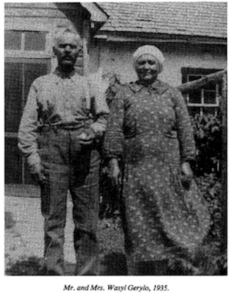
Mr. and Mrs. Wasyl Gerylo, 1935 (submitted by M. Gerylo in 1984)
Mr. Wasyl Gerylo was born in the Western Ukraine, in the village of Monasterok, the province of Borschiv in the year 1877. He came to Canada with his parents, Jacob and Elena Gerylo in the year 1899 and settled in East Selkirk.
It was difficult to find employment but finally he was fortunate to be hired by the Canadian Pacific Railway in Ontario. After staying in Canada for five years he returned to his native land. There he married Tekina Luzny and it was there also that their first son Paul was born (1907). That year he came back to Canada with his wife and son and stayed with his parents until they built their first home which was located next to the Canadian Pacific Immigration Hall. This was before the route of the Canadian Pacific Railway was changed.
Mr. Gerylo worked at the Van Home farm (which was later purchased by the Searle Grain Company) for fifteen years. During this period, their other children were born. Michael was born in 1908, and later were born Metro (1911), Peter (1914), Stephen (1916), Andrew (1918), Thomas (1923), and a daughter Olga (1925). Another daughter Mary, died at birth.
After working at the Van Home farm, he once more found employment with the Canadian Pacific Railway Company. The family was large, wages were low, and the sons had difficulty in finding work, and the depression had set in as well.
One of the sons, Stephen, hoping to find work away from home at the Saskatchewan farms, “hopped the freight” with many others who were doing likewise. But unfortunately, unlike the others, was accidently killed by the train (1932) much to the sorrow of the family.
As we recall, several years later the Second World War broke out and sons Paul, Michael, Peter, Andrew, and Thomas went to serve their country. Andrew was discharged in 1941 due to ill health. Paul, Michael and Peter were with the armed forces in Canada throughout the duration of the war and Thomas spent two years overseas.
Michael married Jean Melnyk and after the war made their home in East Selkirk. Andrew married Beatrice Bazylewski, lived for several years in East Selkirk, then moved to Winnipeg where he was employed until passing away in 1959 at the age of 41. Metro married Catherine Miller and moved to Brooklyn, U.S.A., where he still resides. Paul, Peter, and Thomas did not marry. Paul was accidentally killed in 1967 at the age of 62. Mrs. Gerylo died in 1959, at the age of 71, four months later than her son Andrew and Mr. Gerylo passed away in 1963 at the age of 88. Peter and Thomas are presently living in East Selkirk and Olga, who married Fred Harrison is farming with her husband in the Mayfield district, just on the outskirts of East Selkirk. Their two sons, David and Dennis, who are employed away from home, still do their share of helping on the farm, particularly in the spring, putting the crop in and harvesting in the fall.
This article was written in 1984 and printed in the book 1884-1984 East of the Red (Rural Municipality of St. Clements Centennial Book) p. 550
Many of the family members have since passed away.
Mr. and Mrs. Kologinski
Submitted by their daughter Stella Sul in 1984
My father, Wasyl Kologinski and his brother John immigrated to Canada from Austria in May 1906. They sailed from Belgium and landed in Quebec.
Their parents, Marcus and Euphrosyne Kologinski sold one acre of their land to pay their son’s fare to Canada, so that they could make a better living in the new land.
Wasyl and John first made their way to Winnipeg, being employed with whatever came their way. They also helped build Highway No. 44 to Kenora, Ont. Their brother Michael and sister Mary soon followed. Later their step-brother, Anton, arrived too.
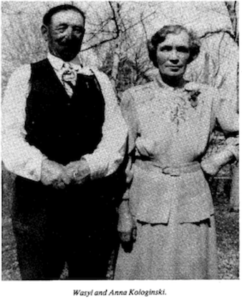
Wasyl and Anna Kologinski
While living in Winnipeg, Wasyl met Anna Shastko and they were married on Oct. 22, 1907 in the St. Nicholas Ukr. Greek Catholic Church, Winnipeg, by Father A. Filipow.
Anna was born in Jabloniw, Poland, on January 19, 1887 and was baptized according to the Rite of the Roman Catholic Church by Rev. Bochtalowski. My mother’s mother, Marina Solnik and her husband Simon, (Step-father) moved to East Selkirk from Winnipeg. My parents soon followed to make their home here also. Colville Road was only a mud road then.
My father was employed for a time by the Manitoba Rolling Mills, and together with his brother-in-law, Nick Solnik, operated the ferry for a few years which took the passengers across the Red River. He also farmed on his small acreage.
My parents had five children, Sophie, Stella, Sally, and twins Johnny and Michael.
Their first parcel of land was 2 acres which they had to clear by hand. I remember our first home that had a veranda. Many happy hours were spent there, playing school or games. Then father bought another six acres of land and had a much more modern house built on it. In fact, that is the first house that Selkirk Lumber Co. built in East Selkirk.
Later, my Dad purchased another eleven acres on Colville road. I recall that this was the site of a gypsy encampment. Some of the village women would go to have their fortune told. My mother warned us never to go near there because the gypsies had a reputation for kidnapping children. Needless to say, we still made our way there out of curiosity.
I recall my Dad telling us that his father Marcus was a musician and would be gone for days playing at weddings and parties. He forbade his sons to play a musical instrument as he said they would never make good husbands. Nevertheless, my Uncle John pursued his love for music and played the violin at weddings, social functions and entertained his family and friends. My father played the Jew’s Harp and always either sang or whistled while he went about his daily chores. I can still picture him riding his bicycle and leading his two horses to the pasture while whistling or humming a tune. I remember our Christmas and especially Christmas Eve, were occasions I could never forget. There was that special feeling and excitement with Christmas Eve approaching and we were busy making sure all was neat and clean for the holidays. Also, as money was scarce, we made our own homemade gifts.
Mother was busy with the cooking and baking and I can recall the lovely aroma of mother frying doughnuts and little prune buns in cooking oil. We would have a real pine Christmas tree and we would make our own Christmas decorations. We would string popcorn and make chains from different colors of crepe paper. We would also hang walnuts and oranges on our tree. To our little minds, this was the most beautiful tree.
As the much-awaited Christmas Eve arrived, the first star appeared, our father would walk in the door with an armful of hay and say a beautiful greeting and wish all the family a long and happy life. He would place a little of the hay on the table which mother covered with a white tablecloth, and the rest of the hay was put under the table. We had great fun hopping in this hay.
Our grandparents would arrive just in time for supper and then twelve meatless dishes were served. After supper, we all sang Christmas carols and our grandmother would always choose her favourite carols. As the years slipped by, we knew them all by heart. The carollers would also come out and ask permission to sing under the window. Of course, they were always welcome and father would give them some money. We could hardly wait to exchange our few precious gifts. I remember when our parents gave us a little tea set that was our most treasured possession.
During the day, relatives and friends would drop in and mother was forever serving food. Yes, I remember, how wonderful it was, with the security and warmth of all the family being together. There will forever be a longing in my heart, if only we could all be together for just one more time.
This article was written in 1984 and printed in the book 1884-1984 East of the Red (Rural Municipality of St. Clements Centennial Book) p. 63
Nazarko Zahayko
Submitted by Ann Chyborak
Nazarko Zahayko was born in Biloze Zlota Galicia Austria on April 3, 1884. Coming to Canada in 1902 as a young man with another man, they stayed in what was then called the Immigration Hall (roundhouse) where they lived. Mr. Zahayko worked at Garson Quarry for many years.
Dora Sawchuk was born on Aug. 2, 1894 in Solkol Village Ukraine. She was 10 years old when she came with her parents, Paul and Alexandria Sawchuk to Canada in 1904. They also stayed in the Immigration Hall, until her parents built a log house not far from the CNR tracks and the road that is now called Colville road. Their neighbours were Sharps, Ogonoski’s and Solomka’s.
Nazarko Zahayko and Dora Sawchuk got married on Feb. 4, 1910 in the Greek Catholic Church in East Selkirk. There the solemnized marriage of Nazarko Zahayko, son of Jurko Zahayko and Elena Shalogan to Dora Sawchuk, daughter of Paul Sawchuk and Alexandria Kobasa the officiating Clergyman was Rev. J. Kusyj.
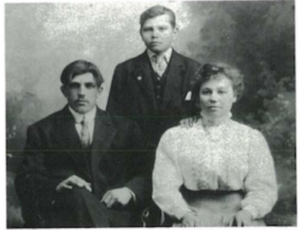
Nazarko Zahayko, Domka (Dora) Sawchuk and son.
Nazarko Zahayko died at 66 years of age on Nov. 20, 1950. Mr. and Mrs. Nazarko Zahayko bought land in East Selkirk and built a house along Coleville road, now across from McLeans P.O. They had five children Nellie, George, Ann, Paul and Doreen. Their neighbours were Kalinski’s, Moses Zegil, Shastko’s and Ewanchuk’s.
Nazarko Zahayko was one of the first men to start working when the C.N.R. section line was built in 1914 or 1915. The section of track they had to work on was 7 miles from Gonor to Poplar Park. Mr. Nickolawchuk (Nickey) was the Section Foreman moving in from Portage la Prairie with his family. They lived with Zahayko’s for a year before the C.N.R. Company fixed up a couple of boxcars for their living quarters and that building was 200 feet from the present C.N.R. station.
Later Mr. Lyzun came to East Selkirk as a Section Foreman and Nazarko was the first man they hired and more men, Mr. Casper Ogonoski, Alex Jacyk, Steve Timo and a few others. Nazarko worked for 29 years, summer and winter, and retired in 1942.
Mr. Zahayko was active in starting the Greek Orthodox Church and the East Selkirk hall. All the meetings were held in our house before the hail was erected father was the janitor for the hall. He kept all the soft drinks at his house to keep them warm otherwise they would freeze in the hall. When there were any concerts or bazaars in the hall, he would take the drinks, I guess in the sleigh, during the winter. The hall was not too far away and it was heated by wood stoves, 2 heaters and the stove pipes were extended from one end of the hall to the other. Father was janitor for the hall for 7 to 8 years. (in 1920’s)
Mrs. Zahayko was a member and cashier for the hall and Church and a member of Benevolent Society and she was active in Ukrainian concerts and Church.
In 1931, Zahayko’s family moved out from East Selkirk to their other farm north of the Star Hotel where it is now, on Harold St. West, along Cooks Creek. Paul and his family live now on the homesite off St. Peters Road. We moved a good size grainary from East Selkirk to the farm and added a leanto on for a kitchen, the other one room was big and we fit our furniture in nicely. A barn was built first for the animals, we also had horses. When milking the cows was finished, we would take the creamers with milk down to the creek and put them into the ice spring water and bring them up in the morning.
The way we plastered our house and barn, and chicken coop, was we gathered dry horse manure and got clay from across the CN track, then we got a good size container to make the mixture. (horse manure, clay, straw, warm water and mix this with our feet or hoe until the mixture was ready, in about one or two hours.) First skinny sticks (willow) would be hammered onto the house and barn and coop to hold the clay mixture on, then we would put white wash on when it was dry.
A new house was built in 1941 or 42. Father had two brothers who came from the Ukraine in the 1920’s, Bill and Mike Zahayko. Bill stayed in Canada for a while but went back to his wife in the Ukraine. Mike stayed and helped his brother, Nazarko, brush the land where the present home is now, this was in 1924-25. Mike left us and we don’t know where he went.
Mrs. Zahayko used to butcher pigs for winter meat, skin it, open it up and save the blood and two kinds of casing, one for buckwheat sausage and small casings for homemade Easter sausage. The bacon would be cut in square pieces, salted and put into boxes for the summer months. Some bacon was left to make lard for pies. All this is done in the fall.
In the fall (1930’s) we would sell potatoes to Sharpe’s and Machewski’s Merchants Store and buy bags of sugar, salt, flour, buckwheat and rice. The rest we had our own, poultry, eggs and milk.
When the parents bought a cabinet radio, it had a battery with a handle, when the battery died, we would have to take it into Selkirk to get it charged up. In a few days we would have to go and get it. We would go from home across the Red River (wintertime) through the Selkirk Park (winter route), we also had a crystal radio and listened to the Chicago barn dances. Our treat for English Christmas was to go to the show on Boxing Day. We did not get presents like kids get now ($300.00 Coleco). For Ukrainian Christmas, Mrs. Lyzun, the section foreman’s wife, gave us box hankies and we gave them turkey for Christmas, and we survived, life was very exciting.
In the summer we walked to Selkirk, we took a short cut from East Selkirk Cemetery through the bush. If we went to the park dance hall we had to be on the ferry by 12 P.M. and we walked home in the dark, because there were no electric lights then (1930’s) and it was just gravel on the roads.
Older people worked hard then, stooking and stacking hay until it got threshed. The way we made our softener for clothes was we would get wood ashes into a container and pour water on it and let it sit for a day or two, because our water from the river was so hard.
Cemetery Story 3- Headstone Evidence
Designs and Symbols
A great deal of information can be found on the markers and headstones used in a cemetery. Unfortunately, many early markers were wooden and decomposed very quickly. Many traditional headstone designs can still be seen in the East Selkirk Cemetery
Ukrainian designed headstones can be the three-barred cross with eight points, the two barred Latin Cross or the two barred Greek cross.
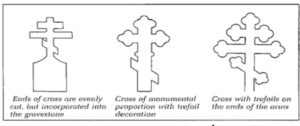
Eight Point Cross
The Three Barred Cross is sometimes called the Eastern Cross. These cemetery crosses were most often stone or cement. The large areas of the crosses were often decorated with designs and painted. The Bukovynian tradition was to use black, red, green and orange on a white surface. The symbols were stars, palms, crosses, flowers and circles.

Three Barred Cross
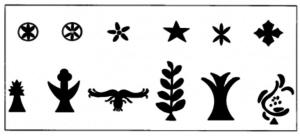
Symbols
Two barred crosses can be divided into three groups: crosses with straight bars, trefoil bars of varying forms and sizes and crosses inscribed within a circle with three arms outward and a lower limb as part of the headstone.
Crosses with traditional Ukrainian features have gradually disappeared and replaced with popular rather than Ukrainian patterns.
Veteran Headstones
The East Selkirk Cemetery has some official Veteran headstones. More information about them was included in the St. Peter Dynevor Cemetery package.
Some names to look for are: Peter Gerylo WWII, Thomas Gerylo WWII, John Roshko WWII and Alexander Hook WWI.
Peter Cole (Kologinski) and Marion Cole
Marion and Peter Cole, 1942 (submitted by Peter Cole)
Peter Cole is the son of Nettie Kordalchuk (born in 1899), and Mike Kologinski (born in 1890). Nettie and Mike were married on Jan. 27, 1913. Peter married Marion Bochantsky in Edmonton on Feb. 14, 1942.
Peter joined the armed services in 1941 and went overseas in June of 1942. Peter served with the 5th Armoured Division wounded in training. Later he changed to the 4th Armoured Division Signal Corps. Peter saw action in England, France, Belgium, Holland, Norway and Germany. At war end he was assigned one year on No. 221 Military Gov’t duties. Peter returned to Canada and was in Calgary in July of 1946, where he received his honourable discharge. When discharged he returned to Edmonton and joined his wife Marion and son Patrick.
Peter soon went to work for Metards Lumber Co., as a truck driver and Marion continued working in the University Hospital as a Nurses Aid, with war amputees. They lived in Edmonton. until July 1947 and returned to East Selkirk. Peter got a job with the Municipality of St. Clements as a heavy equipment operator until 1953.
In 1950 Peter bought 10 acres on Frank Street. On the 10 acres he raised ponies, horses, cows, pigs, chickens, geese, turkeys and later goats. Peter and Marion taught their children responsibility at an early age taking care of animals and birds. At 6:30 am Sunday mornings, before they would arise, the neighborhood children would in vade the barnyard taking turns riding the ponies and bunting with the goats.
In 1954, Peter and Marion and their family moved to Camp Morton. Peter went there to build the campgrounds for The Ukrainian park, and Marion took on the task of head cook until July 1955.
In Sept. Peter began working for the Manitoba Rolling Mills of Selkirk and continues working there today. Marion took part in 4-H Sewing Club as crocheting instructor and together with Julia Kiselevitch, they received many prizes and trophies.
Peter and Marion took an active part in community work. They helped build the skating rink and helped keep it going for many years. Peter was chairman of the East Selkirk Skating Board. Peter served on the Happy Thought School Board as Chairman before and when they consolidated, for at least 7 years. Peter and Marion were very involved with the St. Mary’s Greek Catholic Church. Peter as chairman of the Church board during construction and after it was constructed, while Marion was treasurer on the Women’s Board for many years and a member of the Catholic Women’s league. Many summer years were spent holding picnics on the Cole home grounds raising funds for the construction of the Church.
In 1964, Peter and Marion constructed a new home on Lot 7 Frank St. and they live there until this day. They are presently involved with The Senior Citizen’s Club. Peter and Marion have four children Pat, Will, Marlene, and Ted.
This article was written in 1984 and printed in the book 1884-1984 East of the Red (Rural Municipality of St. Clements Centennial Book) p. 500
Online Resources for Headstone Evidence
Material Culture Review
https://journals.lib.unb.ca/index.php/MCR/article/view/17384/22605
Lost Folk Art in Ukrainian Canadian Cemeteries
http://www.ukrainianchurchesofcanada.ca/lost-folk-art.pdf
Canada GenWeb’s Cemetery Project
http://geneofun.on.ca/cems/MB/MBSTC1741
Find a Grave
https://www.findagrave.com/cemetery/2473545/east-selkirk-cemetery
